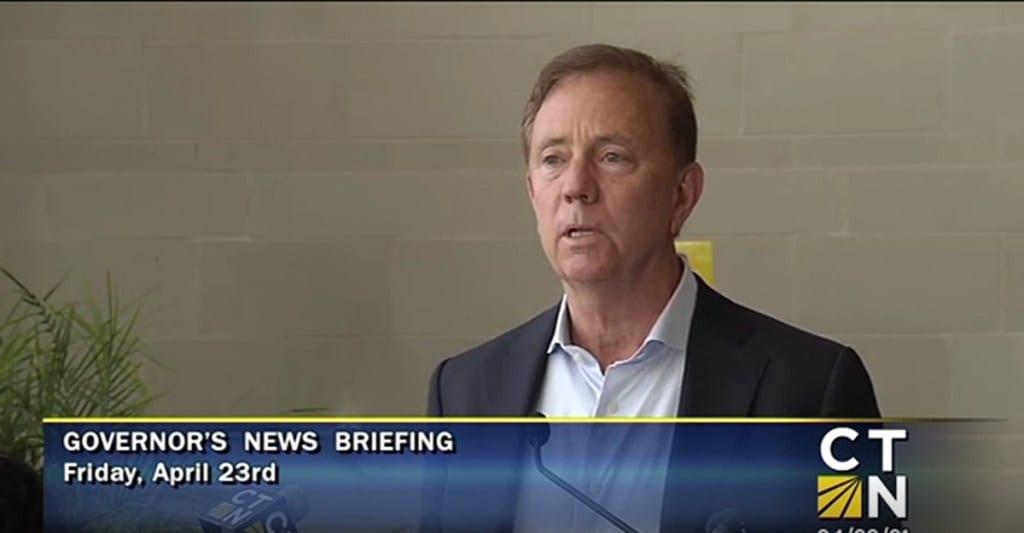Lamont Previews Federal Aid Plan as Differences with Legislative Democrats Emerge

Audio By Carbonatix

Screen capture of Gov. Ned Lamont (courtesy of CTN/CTNewsJunkie.com)
Some of the funding is earmarked for childcare assistance, and Office of Early Childhood Commissioner Beth Bye said she expects the program to help more than 3,000 Connecticut families.
By Hugh McQuaid, CTNewsJunkie.com
Gov. Ned Lamont’s administration proposed investments in child care assistance and small business grants during a Friday preview of its plan to spend roughly $900 million in federal aid left over after the state uses $1.7 billion to close operating deficits.
Budget proposals by both Lamont and majority Democrats in the legislature rely on about $1.75 billion in one-time pandemic assistance from the federal government. Last month, lawmakers passed a bill requiring the governor submit his plan for spending the money to them for approval.
Lamont and several of his agency commissioners offered a summary during a Friday press conference at Naugatuck Valley Community College in Waterbury. The full proposal will be turned over to the legislature on Monday.
“I hope what you hear today is that we have a plan in place that’s going to make sure this money makes a lasting difference for the people hardest-hit by COVID, makes a lasting difference for their communities … and makes a lasting difference for the state of Connecticut,” Lamont said.
The plan comes at a moment of tension between the two branches of government.
On Thursday, the legislature’s Finance Committee approved a tax package to fund the state’s next two-year operating budget which included new taxes largely aimed at wealthy residents. Later that day, Lamont, who has been reluctant to raise taxes on the rich, immediately panned the proposal and said he would not sign it.
During a Friday morning press conference with advocates from the group Recovery For All CT, a group of legislative Democrats signalled they did not intend to concede on their tax proposal. Sen. Gary Winfield, D-New Haven, said the policymakers who have paid lip service recently to the idea of equity needed to be willing to define and fund it.
“You can’t do what you’ve already done and do more without revenue,” Winfield said. “Revenue is required in order to get to equity.”
Sen. John Fonfara, the finance panel’s co-chairman, suggested the governor had not taken the time to understand the committee’s reasons for adopting the tax package. He challenged Lamont’s standing as a Democrat.
“The governor is a Democrat and I think it’s time to back up that designation, that moniker if you will, with substance,” he said.
Lamont was asked to respond to the comments after the preview of his federal aid spending plan. He said the spending plan was his response.
“I think you see one of the greatest investments you can make in kids, in people, in child care that this state has ever seen. You can fuss about state versus federal money. The point is over the next two or three years, it’s going to be transformative,” he said.
Mellisa McCaw, Lamont’s budget chief, said the proposals used the $900 million in pandemic relief funds along with other sources included in the American Rescue Plan Act that was passed by Congress and signed by the president in March.
The Lamont plan will direct funding at a wide range of state operations, including continuing to support Connecticut’s response to the COVID-19 pandemic and its ongoing vaccination program. But Lamont and his agency heads devoted considerable time to the proposal’s efforts to assist Connecticut children and their parents.
Beth Bye, commissioner of the Office of Early Childhood Development, said provisions of the plan include a proposal to scale up home visits by social workers to homes in the first 12 weeks after a baby is born. She said the initiative would focus first on communities hardest hit by the pandemic.
Other elements include funding to enable mothers to return to work. The plan would dedicate about $26 million to helping families meet the qualification threshold for child care assistance. It would extend the program to households making as much as 65% of the state’s median income. That’s up from 50%. Bye said she expected the program to help more than 3,000 Connecticut families.
“Those are big barriers for women who are making choices about ‘Is it worth it for me to go back to work?’ I think that $26 million investment in expanding who can have access to child care subsidies can make a really big difference for middle-class families,” she said.
The plan also directs significant resources at economic development programs. David Lehman, commissioner of economic and community development, estimated that the plan would create or retain more than 80,000 jobs over a five-year period.
Lehman said the proposal would spend $150 million on loans and grants for small businesses. At least half would go to businesses owned by women, veterans, people with disabilities, or people from ethnic minority groups.
Another $150 million will fund projects the department believes will be innovative and create jobs. Lehman said he believed the government investments could be leveraged for as much as $500 million in private investment. The plan would also fund $100 million in grants for transit-connected development projects, he said.
“We think there’s a lot of really great opportunities for the state of Connecticut to truly, as the governor said, move the needle for generations to come,” Lehman said.
Republished with permission from CTNewsJunkie.com, all rights reserved.
Like what you see here? Click here to subscribe to We-Ha’s newsletter so you’ll always be in the know about what’s happening in West Hartford! Click the blue button below to become a supporter of We-Ha.com and our efforts to continue producing quality journalism.



